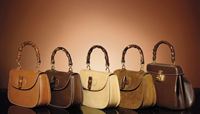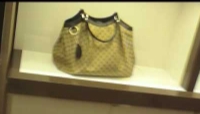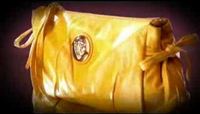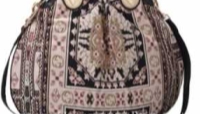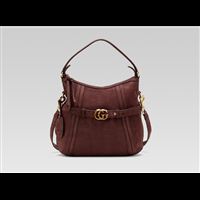News Details
Gucci: Italian fashion infused with actual drama
- By:
- Posted 1/1/0001 12:00:00 AM
- 0 Comments
- 0 Views
- Rating: 0
For nearly 90 years, the Gucci fashion label has been one of the most storied, prestigious, fascinating design houses in the world, and it all began with a saddle and leather goods maker named Guccio Gucci, whose intertwined initials GG became both a logo and a status symbol among the stylish and the wealthy everywhere.
Guccio's sons Vasco, Aldo, Ugo, and Rodolfo went into the company business in the mid 20th century. When Guccio died in 1953, son Aldo built the brand up to a level of international prominence and brought the brand to America, opening a boutique in New York City. But while the Gucci label was gaining worldwide prestige because of the quality and reputation for classiness of the company's offerings, members of the actual Gucci family fought furiously back in Italy over Gucci's future. Board meetings were infamous for fights among family members, and there were reports of luggage, purses, and even tape recorders being hurled in anger.
By the late 1960s, Gucci was expanding into the far east, with new stores in Tokyo and Hong Kong. At this time, the intertwined G logo became famous, as did the style of shoulder bag carried by First Lady Jackie Kennedy and the silk scarf worn by American screen star Grace Kelly.
Aldo Gucci was still in charge in the mid 1970s, still extending the brand's reach into new markets, and planting the seeds of the designer clothing craze of the late 70s with touches like the red and green saddle webbing that became fused with the name Gucci in the minds of consumers. The Gucci family had 14 stores and 46 franchised boutiques worldwide. The fashion label was at the top of its game. Though both Aldo and his brother Rodolfo each controlled half the company, Aldo was much more involved in the day to day operations.
In 1979 Aldo made a decision that ultimately led to a long slide into mediocrity by establishing the Gucci Accessories Collection, or GAC. The decision was intended to improve sales in the company's perfume sector, which Aldo's sons controlled. The Gucci Accessories Collection consisted of small, inexpensive items like make-up bags and pens. Though the items were popular, they flooded the market and diluted the prestige of the brand, particularly among the more wealthy customers who purchased the clothing and leather goods. With the brand no longer exclusive, it became a byword in the early 1980s. Complicating matters further, cheap replicas of Gucci products appeared, further lowering the label's cachet.
Aldo's brother Rodolfo died in 1983, leaving his 50% stake in the company to his son Maurizio. Maurizio formed an alliance with his cousin Paolo to control the Board of Directors. The rest of the family left the company, and not on good terms. Maurizio wanted to stop the family fighting, but he was not successful in the long run.
The company reached its low point in the early 1990s, even though Maurizio had put together a creative team that included a Creative Director named Dawn Mellow, who hired a brilliant young American designer named Tom Ford. Though Maurizio was passionate about the family business, the management of the company gradually concluded that he was ruining the company. Maurizio was forced to sell his shares in 1993 to an investment entity called Investcorp.
At that time De Sole was president and CEO, and he realized that if the brand were to survive it had to go in a completely new direction. It turned out that Ford was the ideal creative director to do just that. Within a few years, the rich and stylish who had turned their noses up at the commodified Gucci of the 1980s began taking a second look at the products. Ford infused the line with two intangibles that have been selling merchandise for time immemorial: glamour and sex appeal. Stylistas the world over loved Ford's designs, and meanwhile Ford was winning award after award in the world of clothing design.
By the early 2000s, Gucci was a multibillion dollar enterprise, having acquired controlling stake in Yves St. Laurent, of which Ford also took charge. Gucci was again at the top of its game, but on an even greater scale than thirty years earlier. That's why everyone who knows anything about fashion design gasped after the 2004 announcement by Ford that he and De Sole would be leaving Gucci.
Fortunately, even with the departure of two of its most powerful people, Gucci still had a solid design team who had trained under Ford. One of them was a young designer named Frida Giannini who became Creative Director and won applause for her collections. Giannini has succeeded by pursuing the timeless chic that made the label a dominant brand in the first place, reviving classics like the Flora scarf that looked so lovely on Grace Kelly in the 1950s. In 2005 she told Time magazine what she believed to be the Gucci mystique: "The Gucci woman enjoys life, is successful in her job and leaves a lasting impression every time she walks into a room."
Fortunately, even for those who will never be able to buy couture, Gucci still has its reputation for beautiful and well crafted accessories including perfume, luggage, sunglasses and silk scarves. The current handbags would almost certainly appear on the arms of style luminaries like Jackie Onassis and Grace Kelly were they still alive. The scarves still look perfectly put together around the necks of eternally chic Parisian women, and Gucci sunglasses are gorgeous and classy enough for the likes of Halle Berry and Nicole Kidman.
The Gucci empire is run with a different cast of characters now than it was during its most turbulent years, but because of the brilliance of its design team, beginning with Tom Ford in 1990, the brand is back on top where it belongs.
Source:
Writer, Fashion Design. Gucci: Italian fashion infused with actual drama:The magnificent, complicated story of one of the world's greatest fashion houses [Internet]. Version 7. Knol. 2009 Apr 16. Available from: http://knol.google.com/k/fashion-design-writer/gucci-italian-fashion-infused-with/uf9htmfyit8g/3.
For nearly 90 years, the Gucci fashion label has been one of the most storied, prestigious, fascinating design houses in the world, and it all began with a saddle and leather goods maker named Guccio Gucci, whose intertwined initials GG became both a logo and a status symbol among the stylish and the wealthy everywhere.
Guccio's sons Vasco, Aldo, Ugo, and Rodolfo went into the company business in the mid 20th century. When Guccio died in 1953, son Aldo built the brand up to a level of international prominence and brought the brand to America, opening a boutique in New York City. But while the Gucci label was gaining worldwide prestige because of the quality and reputation for classiness of the company's offerings, members of the actual Gucci family fought furiously back in Italy over Gucci's future. Board meetings were infamous for fights among family members, and there were reports of luggage, purses, and even tape recorders being hurled in anger.
By the late 1960s, Gucci was expanding into the far east, with new stores in Tokyo and Hong Kong. At this time, the intertwined G logo became famous, as did the style of shoulder bag carried by First Lady Jackie Kennedy and the silk scarf worn by American screen star Grace Kelly.
Aldo Gucci was still in charge in the mid 1970s, still extending the brand's reach into new markets, and planting the seeds of the designer clothing craze of the late 70s with touches like the red and green saddle webbing that became fused with the name Gucci in the minds of consumers. The Gucci family had 14 stores and 46 franchised boutiques worldwide. The fashion label was at the top of its game. Though both Aldo and his brother Rodolfo each controlled half the company, Aldo was much more involved in the day to day operations.
In 1979 Aldo made a decision that ultimately led to a long slide into mediocrity by establishing the Gucci Accessories Collection, or GAC. The decision was intended to improve sales in the company's perfume sector, which Aldo's sons controlled. The Gucci Accessories Collection consisted of small, inexpensive items like make-up bags and pens. Though the items were popular, they flooded the market and diluted the prestige of the brand, particularly among the more wealthy customers who purchased the clothing and leather goods. With the brand no longer exclusive, it became a byword in the early 1980s. Complicating matters further, cheap replicas of Gucci products appeared, further lowering the label's cachet.
Aldo's brother Rodolfo died in 1983, leaving his 50% stake in the company to his son Maurizio. Maurizio formed an alliance with his cousin Paolo to control the Board of Directors. The rest of the family left the company, and not on good terms. Maurizio wanted to stop the family fighting, but he was not successful in the long run.
The company reached its low point in the early 1990s, even though Maurizio had put together a creative team that included a Creative Director named Dawn Mellow, who hired a brilliant young American designer named Tom Ford. Though Maurizio was passionate about the family business, the management of the company gradually concluded that he was ruining the company. Maurizio was forced to sell his shares in 1993 to an investment entity called Investcorp.
At that time De Sole was president and CEO, and he realized that if the brand were to survive it had to go in a completely new direction. It turned out that Ford was the ideal creative director to do just that. Within a few years, the rich and stylish who had turned their noses up at the commodified Gucci of the 1980s began taking a second look at the products. Ford infused the line with two intangibles that have been selling merchandise for time immemorial: glamour and sex appeal. Stylistas the world over loved Ford's designs, and meanwhile Ford was winning award after award in the world of clothing design.
By the early 2000s, Gucci was a multibillion dollar enterprise, having acquired controlling stake in Yves St. Laurent, of which Ford also took charge. Gucci was again at the top of its game, but on an even greater scale than thirty years earlier. That's why everyone who knows anything about fashion design gasped after the 2004 announcement by Ford that he and De Sole would be leaving Gucci.
Fortunately, even with the departure of two of its most powerful people, Gucci still had a solid design team who had trained under Ford. One of them was a young designer named Frida Giannini who became Creative Director and won applause for her collections. Giannini has succeeded by pursuing the timeless chic that made the label a dominant brand in the first place, reviving classics like the Flora scarf that looked so lovely on Grace Kelly in the 1950s. In 2005 she told Time magazine what she believed to be the Gucci mystique: "The Gucci woman enjoys life, is successful in her job and leaves a lasting impression every time she walks into a room."
Fortunately, even for those who will never be able to buy couture, Gucci still has its reputation for beautiful and well crafted accessories including perfume, luggage, sunglasses and silk scarves. The current handbags would almost certainly appear on the arms of style luminaries like Jackie Onassis and Grace Kelly were they still alive. The scarves still look perfectly put together around the necks of eternally chic Parisian women, and Gucci sunglasses are gorgeous and classy enough for the likes of Halle Berry and Nicole Kidman.
The Gucci empire is run with a different cast of characters now than it was during its most turbulent years, but because of the brilliance of its design team, beginning with Tom Ford in 1990, the brand is back on top where it belongs.
Source:
Writer, Fashion Design. Gucci: Italian fashion infused with actual drama:The magnificent, complicated story of one of the world's greatest fashion houses [Internet]. Version 7. Knol. 2009 Apr 16. Available from: http://knol.google.com/k/fashion-design-writer/gucci-italian-fashion-infused-with/uf9htmfyit8g/3.

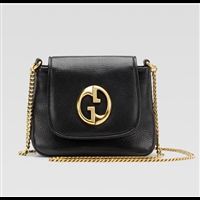
- Seller: username
- Posted 1 hour ago
- Seller: username
- Posted 1 hour ago

